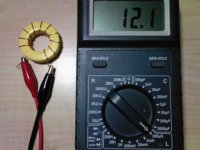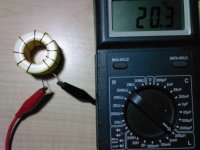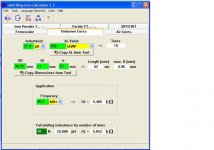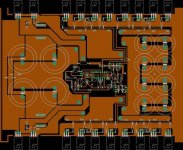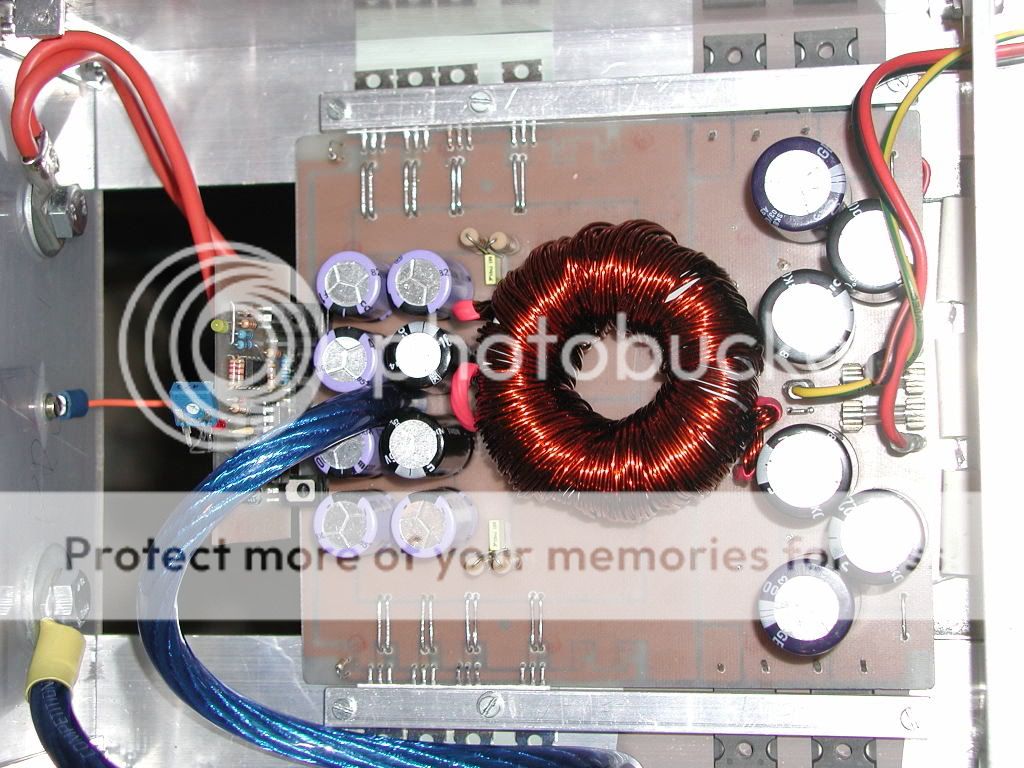Do you have an inductance meter and a frequency meter or oscilloscope? If you know the frequency which the meter operates at we can extract at least the basic parameters by testing a known number of turns of wire around one of the cores.
This pdf describes the process in general terms.
http://www.steward.com/pdfs/cores/ferrprop.pdf
It is in my interest to learn more about ferrite properties for my job, so I will try to find out exactly how to extract the parameters from the measurements. If you could just describe the tools you have available, I'm sure we can walk through the process of measurement.
Regards,
David
This pdf describes the process in general terms.
http://www.steward.com/pdfs/cores/ferrprop.pdf
It is in my interest to learn more about ferrite properties for my job, so I will try to find out exactly how to extract the parameters from the measurements. If you could just describe the tools you have available, I'm sure we can walk through the process of measurement.
Regards,
David
Measurements
I have all three measurement devices.
The inductance meter I have just measured and it runs at 100Hz
On a side note, I have measured my spare cores for those that wish to know.
OD 38.75 mm
ID 21 mm
H 11.2 mm
I stack two together before winding, so the actual combined core is
OD 38.75 mm
ID 21 mm
H 22.4 mm
I have all three measurement devices.
The inductance meter I have just measured and it runs at 100Hz
On a side note, I have measured my spare cores for those that wish to know.
OD 38.75 mm
ID 21 mm
H 11.2 mm
I stack two together before winding, so the actual combined core is
OD 38.75 mm
ID 21 mm
H 22.4 mm
I found a very neat program that could help. It was written by a HAM for calculating unknown cores and selecting cores for RFI rejection.
It is the "mini ring core calculator" located here:
http://www.dl5swb.de/html/software_for_amateur_radio.htm
I'm not sure that a 100Hz measurement will extrapolate well to 40kHz; you wouldn't happen to have access to an impedance analyzer would you?
If not it couldn't hurt to give the program a try at 100Hz, just to see what it says.
If you don't mind, just wrap a few turns around the core and tell me what number of turns and what inductance is read, and I will try to calculate the parameters. At least this will give us some experience with the measurements. I will try some known cores I have and see how well the data extrapolates from 100Hz to 40kHz.
Regards,
David
It is the "mini ring core calculator" located here:
http://www.dl5swb.de/html/software_for_amateur_radio.htm
I'm not sure that a 100Hz measurement will extrapolate well to 40kHz; you wouldn't happen to have access to an impedance analyzer would you?
If not it couldn't hurt to give the program a try at 100Hz, just to see what it says.
If you don't mind, just wrap a few turns around the core and tell me what number of turns and what inductance is read, and I will try to calculate the parameters. At least this will give us some experience with the measurements. I will try some known cores I have and see how well the data extrapolates from 100Hz to 40kHz.
Regards,
David
theAnonymous1 said:What about these cores?
Those look too small, but too big to stack them and use 2 trafos like that, but yea they would work if material is right. To put into perspective I have on mine 325mm^2 cross section and a lot of wire
I just did a quick test and have verified that there will be some error by testing at the lower frequency, but the information is still useful.
I used 10 turns and measured 1.72mH at 100Hz on one of my cores. At 40kHz with 10 turns I measured 1.583mH. That is within 10%, and according to the calculator software, standard production tolerances can vary by up to 30%.
What inductance does your core measure with 10 turns of wire around it?
Regards,
David
I used 10 turns and measured 1.72mH at 100Hz on one of my cores. At 40kHz with 10 turns I measured 1.583mH. That is within 10%, and according to the calculator software, standard production tolerances can vary by up to 30%.
What inductance does your core measure with 10 turns of wire around it?
Regards,
David
Measurements
I was also wondering about 100Hz 40Khz not being realistic, but surely there's some published curves. I think these cores are plain old powdered iron inside.
The measurements are as follows.
10 turns EXACTLY of 0.7mm wire
Single core: 12.1 uH
Double core: 20.4 uH
Shouldn't it be exactly double?
I was also wondering about 100Hz 40Khz not being realistic, but surely there's some published curves. I think these cores are plain old powdered iron inside.
The measurements are as follows.
10 turns EXACTLY of 0.7mm wire
Single core: 12.1 uH
Double core: 20.4 uH
Shouldn't it be exactly double?
Attachments
Been doing some research here
I'm becomming very sure what I have here is a powdered iron core material J75 yellow/white color code with most manufacturers 1Khz to 1Mhz, sutable for tuned transformers
Almost everything else is rated for several Mhz
So I need to go find another core J75 material of "X" size and wind myself some experimental trafo's
Now what size is "X"? what parameter am I looking for?
I'm becomming very sure what I have here is a powdered iron core material J75 yellow/white color code with most manufacturers 1Khz to 1Mhz, sutable for tuned transformers
Almost everything else is rated for several Mhz
So I need to go find another core J75 material of "X" size and wind myself some experimental trafo's
Now what size is "X"? what parameter am I looking for?
http://www.micrometals.com/pcparts/PC_L.pdf
Yellow/white is also used for micrometals -26 material. The T150-26 on page 10/12 is a possibility. Where did you get the AL value of 200?
The AL value for the T150-26 is 96.
I use F or P cores (P-material preferred). I measured a P-core with 10 turns. The inductance was 409uH. The AL value for this core is 3,366.
Using the formula (from Mag-inc literature):
L(mH) = AL*N^2/1000^2
L = 3366*100/1000000
L = 0.336mH or 336uH
That's relatively close to the measured value.
Using the formula above, it appears that the cores have an AL of ~120. Close to the AL of 96 for the -26 material.
For reference, the initial permeability of the P material is 2500.
Yellow/white is also used for micrometals -26 material. The T150-26 on page 10/12 is a possibility. Where did you get the AL value of 200?
The AL value for the T150-26 is 96.
I use F or P cores (P-material preferred). I measured a P-core with 10 turns. The inductance was 409uH. The AL value for this core is 3,366.
Using the formula (from Mag-inc literature):
L(mH) = AL*N^2/1000^2
L = 3366*100/1000000
L = 0.336mH or 336uH
That's relatively close to the measured value.
Using the formula above, it appears that the cores have an AL of ~120. Close to the AL of 96 for the -26 material.
For reference, the initial permeability of the P material is 2500.
Thank you Perry. What are the specs on that power supply? Voltage on outputs, dimensions of core, power output?
The core I have is fairly small (36mm OD 23mm ID 15mm Height), but has a very high permeability. It is this core: http://search.digikey.com/scripts/DkSearch/dksus.dll?Detail?name=240-2537-ND . The AL is rated at 13440 nH/N^2, permeability is 10000. Obviously with my core measuring between 1.7mH and 1.5mH, the actual AL of this particular core is closer to 15000 nH/N^2 at the frequencies of interest.
It would most certainly saturate in this application, because the area is not very large for such a high permeability.
I have some other cores that have lower permeability, I'll measure them tomorrow to see if they are closer to what you have there.
What I am learning here is that different voltages and frequencies are going to require different core types. This is definitely going to take some more homework on my part.
I'll come back to this thread tomorrow with an update on what I've found.
Regards,
David
The core I have is fairly small (36mm OD 23mm ID 15mm Height), but has a very high permeability. It is this core: http://search.digikey.com/scripts/DkSearch/dksus.dll?Detail?name=240-2537-ND . The AL is rated at 13440 nH/N^2, permeability is 10000. Obviously with my core measuring between 1.7mH and 1.5mH, the actual AL of this particular core is closer to 15000 nH/N^2 at the frequencies of interest.
It would most certainly saturate in this application, because the area is not very large for such a high permeability.
I have some other cores that have lower permeability, I'll measure them tomorrow to see if they are closer to what you have there.
What I am learning here is that different voltages and frequencies are going to require different core types. This is definitely going to take some more homework on my part.
I'll come back to this thread tomorrow with an update on what I've found.
Regards,
David
Hi
Well I am a bit scared testing it in car and I really can't, since I don't live in house...but at home, I used today my modded pc supply about 25A @ 12.19 in, 2.923A at 98.4v...when I had it in car, engine on, there was 123v, so ~+/-62V, does this with such ease I can't believe, probably when loaded a lot it will do +/-55v which is great for AMP2...one day, I will loaded in car just to see what it can do...probably a lot, since some other people use the same core and get 1.5kw out easy
Well I am a bit scared testing it in car and I really can't, since I don't live in house...but at home, I used today my modded pc supply about 25A @ 12.19 in, 2.923A at 98.4v...when I had it in car, engine on, there was 123v, so ~+/-62V, does this with such ease I can't believe, probably when loaded a lot it will do +/-55v which is great for AMP2...one day, I will loaded in car just to see what it can do...probably a lot, since some other people use the same core and get 1.5kw out easy
Hi
I won't have no input choke, fuse is already in, right next to battry at front, then cable goes into cabin and to amp... I could unplug it and connect this smps right away... Just to be clear, 123v is not single rail, but both. Should get about 750w sinus and probably even more, since voltage won't sag so much....so probably 900w pure solid base , or dual 400w into 4R, for doors? haha would probaly break them
, or dual 400w into 4R, for doors? haha would probaly break them 
I won't probably go into lower resistance, even that sub is dual 4R, will have it in series...
I won't have no input choke, fuse is already in, right next to battry at front, then cable goes into cabin and to amp... I could unplug it and connect this smps right away... Just to be clear, 123v is not single rail, but both. Should get about 750w sinus and probably even more, since voltage won't sag so much....so probably 900w pure solid base
I won't probably go into lower resistance, even that sub is dual 4R, will have it in series...
- Status
- This old topic is closed. If you want to reopen this topic, contact a moderator using the "Report Post" button.
- Home
- General Interest
- Car Audio
- Any interest Car SMPS
